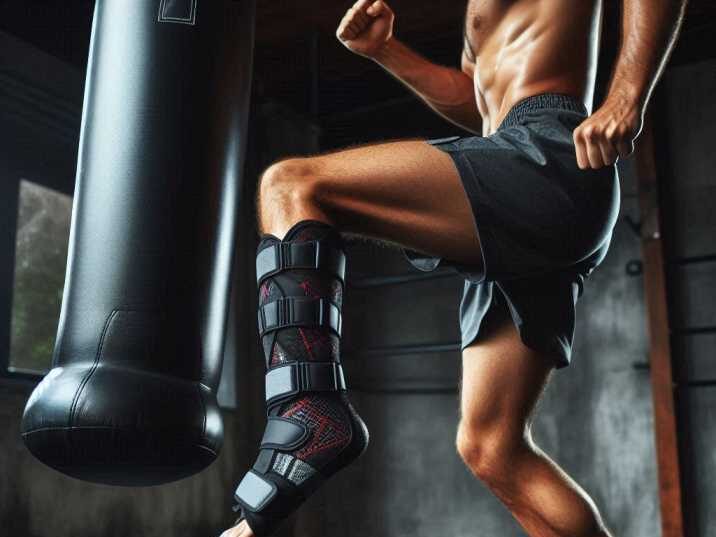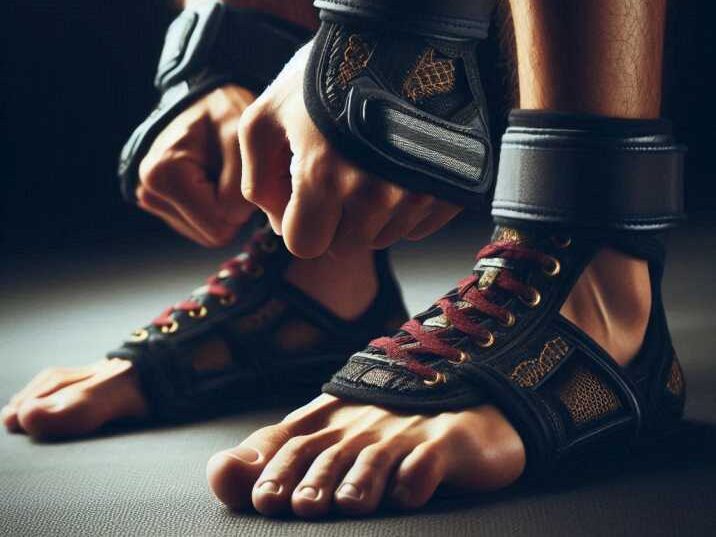Introduction
Table of Contents
Muay Thai, also known as the “Art of Eight Limbs,” is a combat sport that uses punches, kicks, elbows, and knee strikes. Because of its intense footwork and explosive movements, fighters need ankle support to prevent injuries and enhance performance. But why Muay Thai fighters wear ankle supports? Let’s explore the key reasons.

1. Preventing Ankle Injuries
Protecting Against Sprains and Strains
Muay Thai training involves frequent pivoting, jumping, and rapid directional changes, which can strain the ankles. Without proper support, fighters risk sprains or ligament damage. Ankle supports provide compression and reinforcement, minimizing the chance of injury while allowing mobility.
Reducing Impact Stress
Every strike a fighter delivers generates force that travels through the foot and ankle. Without protection, these repeated impacts can lead to joint pain and stress-related injuries. Ankle wraps act as a shock absorber, dispersing force and reducing strain on delicate ligaments and bones.
2. Enhancing Stability and Balance
Improved Footwork
Muay Thai relies on precise and agile footwork for offense and defense. Sudden weight shifts and quick pivots can cause instability. Ankle supports reinforce the ligaments, providing a stable base for movements and improving overall balance.
Better Weight Distribution
Balanced weight distribution is key to maintaining control in a fight. Ankle wraps align the foot properly and provide extra grip, reducing the likelihood of slipping or rolling an ankle. This stability helps fighters stay grounded during intense exchanges.
3. Supporting Weak or Healing Ankles
Aid in Recovery
Fighters recovering from previous ankle injuries require extra support during training. Ankle wraps gently compress the affected area, stimulating blood flow and reducing swelling, which speeds up the healing process.
Reinforcing Strength
Some fighters naturally have weaker ankles or experience frequent discomfort. Ankle supports act as an extra layer of reinforcement, allowing fighters to train without the constant fear of re-injury, promoting long-term strength and endurance.
4. Increasing Comfort During Training
Reducing Friction and Blisters
Hard training surfaces like mats or the ring canvas create friction that can cause blisters and skin irritation. Ankle wraps reduce direct contact between the skin and the surface, protecting against painful abrasions and discomfort.
Absorbing Sweat
Muay Thai is an intense workout that generates excessive sweating. Damp feet can lead to slips, discomfort, and hygiene issues. Ankle wraps absorb sweat, keeping the feet dry and preventing unnecessary distractions during training or fights.
5. Psychological Confidence Boost
Feeling More Secure
A fighter’s confidence is crucial to their performance. Wearing ankle supports provides a sense of security, allowing fighters to execute movements with full commitment, knowing their ankles are protected.
Part of Pre-Fight Rituals
Many fighters wear ankle wraps as part of their pre-fight routine. Some believe they bring luck or protection, while others find comfort in the familiarity of wearing them before stepping into the ring.
6. Providing Mild Compression for Circulation
Preventing Swelling
Long training sessions can lead to swollen feet and ankles due to prolonged movement and impact. Compression from ankle wraps promotes healthy circulation, reducing inflammation and discomfort.
Aiding in Recovery
By improving blood flow and oxygen delivery, ankle wraps assist in faster muscle and ligament recovery, helping fighters return to training quicker and preventing stiffness after intense workouts.
7. Traditional and Aesthetic Appeal
A Symbol of Dedication
In Thailand, ankle wraps symbolize discipline and respect for the art of Muay Thai. Many fighters wear them as a badge of commitment, honoring the sport’s traditions.
Matching Fight Gear
Beyond function, ankle wraps allow fighters to express their personal style. Many choose customized colors and designs that match their shorts and gloves, adding to their overall presence in the ring.

Table: Benefits of Wearing Ankle Supports in Muay Thai
| Benefit | How It Helps |
|---|---|
| Injury Prevention | Protects against sprains and fractures |
| Stability & Balance | Enhances footwork and weight distribution |
| Recovery Support | Helps in healing past injuries |
| Comfort & Sweat Absorption | Reduces friction and prevents blisters |
| Confidence Boost | Makes fighters feel secure and strong |
| Improved Circulation | Prevents swelling and aids in muscle recovery |
| Traditional Appeal | Part of Thai fighting culture and aesthetics |
Conclusion
Ankle supports are an essential part of a Muay Thai fighter’s gear. They help prevent injuries, enhance stability, aid in recovery, and provide psychological confidence. Whether you’re a beginner or a seasoned fighter, using ankle wraps can improve your training experience and performance in the ring.
FAQs
1. Can I train Muay Thai without ankle supports?
Yes, but ankle wraps help prevent injuries and provide stability, so they are highly recommended.
2. What type of ankle wraps do Muay Thai fighters use?
Most fighters use elastic or cotton ankle supports, which provide compression without restricting movement.
3. Do ankle supports help with shin conditioning?
Not directly, but they can reduce discomfort when checking kicks, especially for beginners.
4. How tight should ankle wraps be?
They should be snug but not too tight—tight enough for support but loose enough to allow proper blood circulation.
5. Are ankle wraps allowed in professional fights?
Yes, most professional Muay Thai organizations allow ankle wraps, but some promotions have specific rules on colors and branding.


